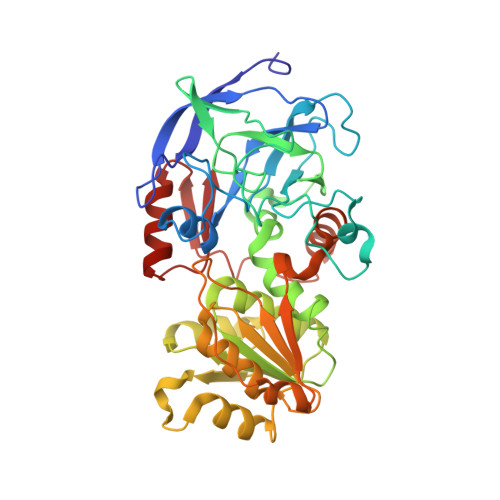Substitutions in the Flexible Loop of Horse Liver Alcohol Dehydrogenase Hinder the Conformational Change and Unmask Hydrogen Transfer
Ramaswamy, S., Park, D.H., Plapp, B.V.(1999) Biochemistry 38: 13951
- PubMed: 10529241
- DOI: https://doi.org/10.1021/bi991731i
- Primary Citation of Related Structures:
1QLH, 1QLJ - PubMed Abstract:
When horse liver alcohol dehydrogenase binds coenzyme, a rotation of about 10 degrees brings the catalytic domain closer to the coenzyme binding domain and closes the active site cleft. The conformational change requires that a flexible loop containing residues 293-298 in the coenzyme binding domain rearranges so that the coenzyme and some amino acid residues from the catalytic domain can be accommodated. The change appears to control the rate of dissociation of the coenzyme and to be necessary for installation of the proton relay system. In this study, directed mutagenesis produced the activated Gly293Ala/Pro295Thr enzyme. X-ray crystallography shows that the conformations of both free and complexed forms of the mutated enzyme and wild-type apoenzyme are very similar. Binding of NAD(+) and 2,2, 2-trifluoroethanol do not cause the conformational change, but the nicotinamide ribose moiety and alcohol are not in a fixed position. Although the Gly293Ala and Pro295Thr substitutions do not disturb the apoenzyme structure, molecular modeling shows that the new side chains cannot be accommodated in the closed native holoenzyme complex without steric alterations. The mutated enzyme may be active in the "open" conformation. The turnover numbers with ethanol and acetaldehyde increase 1.5- and 5.5-fold, respectively, and dissociation constants for coenzymes and other kinetic constants increase 40-2,000-fold compared to those of the native enzyme. Substrate deuterium isotope effects on the steady state V or V/K(m) parameters of 4-6 with ethanol or benzyl alcohol indicate that hydrogen transfer is a major rate-limiting step in catalysis. Steady state oxidation of benzyl alcohol is most rapid above a pK of about 9 for V and V/K(m) and is 2-fold faster in D(2)O than in H(2)O. The results are consistent with hydride transfer from a ground state zinc alkoxide that forms a low-barrier hydrogen bond with the hydroxyl group of Ser48.
Organizational Affiliation:
Department of Molecular Biology, Swedish University of Agricultural Sciences, Uppsala.















